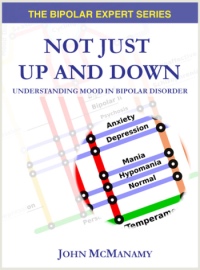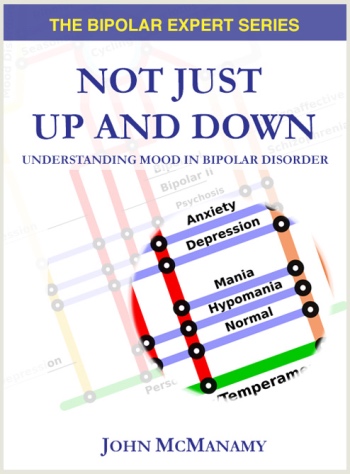The Fear and Anger Equation
 |
Hagop Akiskal's theory of practically everything.
|
Akiskal and mood and temperament. Do fear and anger underpin practically every mood and personality state? What kind of crazy question is that?
Hagop Akiskal MD of the University of California at San Diego thinks he may have an answer.
Dr Akiskal is no fan of the DSM approach of separating out psychiatric phenomena into neat diagnostic parcels. The dynamics of mood and temperament, and their interactions, are far too messy for that, especially when they involve mixed depressions that behave suspiciously like bipolar disorder.
My New Book!

Purchase now.
The reality may be messy, but Dr Akiskal, like any great thinker, is always in search of an elegant explanation. In two online advance articles from The Journal of Affective Disorders in 2006, with Brazilian collaborator Diogo Lara MD as one of his co-authors, Dr Akiskal has proposed what can best be described as a "fear-anger dysregulation hypothesis." First some background ...
Temperaments and Emotions
Dr Akiskal broadly divides personality into four temperaments, including hyperthymic, cyclothymic, depressive, and anxious, each conferring certain adaptive advantages. Hyperthymics are the leaders, energetic and upbeat. Cyclothymics are the creative romantics. Depressives tend to be subservient (someone has to take orders and do the grunt work), while anxious types lean toward altruism. These traits are distributed along a continuum ranging in degree from normal and supernormal to the sturm and drang of mood disorders.
A far more complicated model is that of Robert Cloninger MD of Washington University (St Louis), which breaks down emotions into fear (harm avoidance), anger (novelty seeking), attachment (reward dependence) and ambition or determination (persistence). Bundled into these emotions are a host of characteristics. For instance, novelty seekers tend to be impulsive, irritable, and in search of immediate gratification while those with low fear tend to be optimistic and outgoing and energetic.
Recently, Drs Akiskal and Cloninger joined forces. In a 2005 study of a general population of youths, they showed that the hyperthymic temperament correlated positively with novelty seeking (anger), and negatively with harm avoidance (fear). Depressives recorded the exact opposite, while cyclothymics were both fearful and novelty seeking. An additional study on adults correlated these findings.
Enter the Hypothesis
This is where Drs Akiskal and Lara drop their bombshell. In the first of their two articles, they advance the notion that "basic mood states, both normal and pathological, can be conceived mostly as a function of transiently dysregulated or accentuated fear and anger traits." Moreover, they submit that "their combinations and various permutations can predict all major mood profiles, both pathological and healthy."
Whoa! Fear and anger for ALL of mood, healthy and otherwise? Is this the new E=MC2 of psychiatry?
"Fear is the path of the Dark Side. Fear leads to anger, anger leads to hate, hate leads to suffering." Is it really that simple? Is cutting edge psychiatry nothing more than a remedial attempt to catch up to Master Yoda?
Okay, let's assume that Dr Akiskal has not seen too many Star Wars movies. First, let's clear up what Dr Akiskal means by anger, which is not necessarily what you encountered as a kid when you tracked mud over your mom's freshly-waxed kitchen floor. When high anger is coupled with low fear, we are talking about the "sunny side," characterized by pleasure seeking and grandiosity. But add more fear to the mix and we arrive at anger's more familiar "dark side."
Oops, maybe Dr Akiskal has watched too much Star Wars, after all.
Earlier mood spectrum models call for thinking linearly, in one dimension. Now, Dr Akiskal asks us to think bi-dimensionally.
Thinking Inside the Box
Drs Akiskal and Lara ask you to imagine a square tipped on one corner, sort of like a diamond-shaped compass.
The "north" pole is "hyperthymic," bracketed by low fear and high anger. The "south" pole, "depression," is bracketed by low anger and high fear. Now add a west-east axis and you get something like this:
Low fear |
hyperthymic |
High anger |
||
|
hyperactive |
irritable |
|||
|
labile (volatile) |
euthymic |
cyclothymic |
||
|
apathetic |
anxious |
|||
Low anger |
depressive |
High fear |
Say the authors: "Since cyclothymic and hyperthymic temperaments predispose to bipolar disorder, high anger would be the distinguishing feature of bipolar spectrum disorders." In bipolar disorder, fear modulates the anger. The authors contend that their model also applies to behavioral characteristics that are not disorders, such as entrepreneurship and leadership in hyperthymic individuals. The model does not cover schizophrenia, schizoaffective, and schizoid personality disorder, nor pervasive developmental disorder.
Thinking Inside the Box - Part II
The authors have thoughtfully provided an additional tilted square. Depressive stays the same, but this time "euphoric" occupies the opposite pole, while "dysphoric" becomes labile's opposite. Plus some additional blanks (simplified here) are filled in, as such:
| Low fear |
|
euphoric |
|
High anger | |||
|
Distraction, disinhibited impulsivity | Jocular, grandiosity | (M,H,d) | Pleasure seeking, goal directed behavior | Agitation, appetitive impulsivity |
|
|
| labile | (ad/h, AD) | euthymic | (mx, cy) | dysphoric | |||
|
Irritation, lack of goals | Apathy |
(D, dys) |
Sadness, anhedonia, insecurity | Anxiety, hyper-sensitivity |
|
|
| Low anger |
|
depressive |
|
High fear | |||
Various manic and hypomanic states (with short-lived depressions) occupy the top part of the square just below euphoric (M,H,d). Working down from euphoric to dysphoric, pure mania gives way to mixed states and cycling (mx, cy). Working the other way from euphoric to labile, mania gives way to attention deficit/hyperactivity and atypical depression (.ad/h, AD)
Down at the bottom we have depression (D) and dysthymia (dys) which merges into labile features working one way up the square and dysphoric the other way. Everything starts to quiet down as we approach euthymic from any direction.
As you can see, according to Drs Akiskal and Lara, not all depressions and manias are alike. Different types feed off differing degrees of fear and anger, typically high of one and low of the other, but often a mix of both. In their article, the authors add that atypical depression involves a "transient downregulation of anger traits," while cycling involves both high fear and high anger, "as one pulls up and the other pulls down."
Thinking Inside the Box - Part III
Yes, high fear and anger may drive cycling, but guess what? The authors also say that high fear and anger underpins anxiety, neuroticism, and interpersonal sensitivity without mood cycling.
Does one detect a hostile takeover of the personality disorders branch of psychiatry? Funny you should ask. Drs Akiskal and Lara offer up yet another tilted square, which we will compassionately not include here. What you need to know is that the fear-anxiety brackets are retained, but we have entirely new axes that involve "affective lability"-"emotional instability", "internalizing"-"externalizing", "reckless impulsivity"-"compulsivity", and "low drive and focus"-"appetitive impulsivity". Spread inside the box are traits that account for just about every personality defect known to humankind, from pathological gambling to OCD to borderline personality disorder.
But please do not interpret this additional square to mean that mood disorders are distinct from personality disorders. As Drs Akiskal and Lara are quick to point out, the separation "is for didactic purposes only." Instead, the authors submit that "dysregulation in fear and anger" is the common underlying cause for "the observed patterns of comorbidity [co-occurrence] between these disorders." No, mania does not equate with antisocial personality disorder, but elements of the two may be connected through similar fear and anger traits.
So basically, the E=MC-squared of mood becomes the E=MC-cubed of mood AND personality. By joining personality to mood, Dr Akiskal has come up with his version of a grand unified theory for practically everything. But does he have the brain science to back it up? Read on ...
The Brain Science
Just so there is no room for misinterpretation, Drs Akiskal and Lara, at the beginning of their second article, spell it out: "It is hypothesized that mood, behavioral and personality disorders share a neurobiological substrate according to combinations of fear and anger traits."
According to Akiskal and Lara, the emotions of fear and anger are primitive and based in the ancient limbic regions, particularly the amygdala, while well-developed cortical regions have a modulatory rather than primary role.
Dopamine and anger - Dopamine is a key neurotransmitter in the modulation of anger and novelty-seeking. Intriguingly, sensory gating "prepulse inhibition," which is highly influenced by dopamine activity, has been shown to be deficient in both manic patients and in pathological gambling.
A genetic variation of the dopamine D2 receptors has been linked to novelty-seeking, impulsivity, antisocial personality, and alcohol dependence. The time course for the onset of mania, impulsive and substance use disorders (all anger-related) coincides with dopamine DR2 availability and novelty-seeking traits in youth and young adulthood. Decay in DR2 binding as people age may account for age-related maturity and less impulsivity and improvement in such personality disorders such as borderline.
Meanwhile, key alterations may be found in other neurotransmitter systems (such as glutamate) that interact with and regulate the dopamine system.
Serotonin, Noradrenalin, and Fear - A variation in the serotonin transporter gene has been linked to a heightened response in the amygdala and fear treats in healthy individuals. The same gene variation has also been implicated in stress-induced depression. In mice, higher serotonin predisposes to anxiety while in primates lower serotonin predicts lack of impulse control.
High noradrenaline (associated with distractibility and goal-directed behavior) may take place in euphoric mania and ADHD while low noradrenaline may be associated with atypical depression.
Also in the Fear Mix - A "robust body of evidence" supports GABA in the modulation of anxiety and fear. Other suspects include the BDNF receptor, the neuromodulator adenosine (caffeine blocks the A1 and A2 receptors), cortisol, and vasopressin.
Drs Akiskal and Lara are not citing the brain science as proof for their hypothesis. At best, it is merely supporting evidence. In other cases, it is speculative.
Genetic and Environmental Influences
"It would be surprising to find genes for specific diagnostic categories as presently conceived in diagnostic manuals," say the authors, citing Dr Cloninger. The authors refer to genetic data in support of the view that hyperthymic and cyclothymic subjects, for example, may share the same neurobiology and genetics for anger, but may be opposite regarding fear. Nevertheless, they acknowledge that their model does not preclude the possibility of other regulatory genes playing a role in the genetics of psychiatric disorders. The authors argue that comparing opposite extremes (such as high and low fear) with normal controls (medium fear) would increase the chance of finding relevant genes.
But genes alone are not the only determinants of fear and anger. Early life events can loom large. Conversely, fear and anger qualities can determine an individual's response to these events. Finally, environmental influence may be therapeutic. The authors speculate that the absence or presence of major life stressors could determine whether or not high fear and anger manifest as say cyclothymic bipolar disorder in one individual or borderline personality disorder in another, and, with acute intense stress, PTSD in yet another.
To explain the seeming rise in anger-related disorders, the authors speculate that the presence of higher environmental stimulation in modern society may play a role. "Low functional fertility" in high fear-low anger individuals and higher sexuality of hyperthymic individuals may also drive the selection for "stronger temperaments."
Meds for Fear and Anger
Drs Akiskal and Lara run through the meds already well-known to us, but they have made a major conceptual leap - whereas we think of these drugs as mood stabilizers and antipsychotics and antidepressants and anti-anxiety agents, they are talking in terms of modulators of fear and anger. To the authors, if a certain medication works well for mood-related anger, it makes sense the same med may show benefit for personality-related anger.
In essence, the authors are saying, don't be fooled by phenotype, a set of diagnostic symptoms. Look also to endophenotype, which may be closer to the underlying cause.
Antipsychotics with their dopamine antagonism (as well as various mood stabilizers) are obvious candidates for high anger while dopamine-enhancers such as Wellbutrin and Mirapex may work the other side of the street for low anger. Serotonin meds come to mind for high fear. The authors make a distinction between "state" and "trait." Stress-induced depression, they maintain, may be easier to treat and result in quicker recovery, while extremely high fear calls for aggressive dosing and a lot of patience.
Life is not simple, and various manic states are proof positive. A better understanding of the fear and anger dimensions in mania may lead to more rational drug treatments.
Higher anger meds, as well as working for mania, may also be effective for cluster B personality disorders (which includes borderline) while antifear drugs may work for both depression and cluster C personality disorders (such as avoidant and dependent personality disorders).
Final Word
The Journal of Affective Disorders lists both articles as "special review," which does the authors a considerable injustice. True, the two pieces draw extensively from Dr Akiskal's earlier work, plus the labors of a vast range of experts, but the way the authors have pulled together their material and assembled the bits and pieces is strikingly ambitious and original.
Grand theories of everything, of course, beg to be attacked, and Dr Akiskal is no exception. After all, is something as complex as the human psyche truly reducible to just two traits? And if we are talking about a vast encompassing spectrum, why only two primary colors? Why not promote impulsivity to primary color status? And what happened to sleep, which is mentioned only in passing?
Critics may pull Dr Akiskal's theory apart, or a new scientific discovery may blow his vision to smithereens. But that is not the point. Genetics and neurobiology are redefining psychiatry, not to mention new insights advanced by the thinkers and observers of human experience. But until visionary thinkers attempt to connect the dots, we will have no clear picture, no conceptual framework for making sense out of the new, much less reconciling the old. Dr Akiskal's grand theory of everything is on the table. Let the conversation begin ...
May 12, 2007, reviewed Jan 6, 2011
 |
More articles on behavior. |




